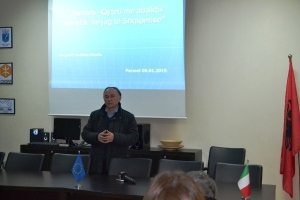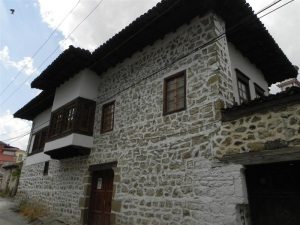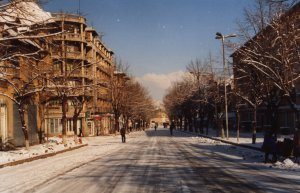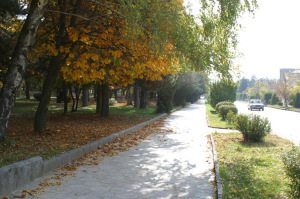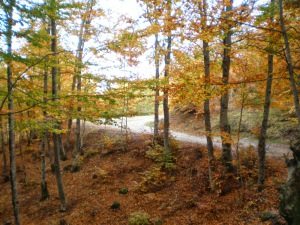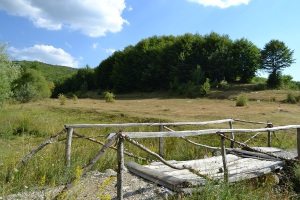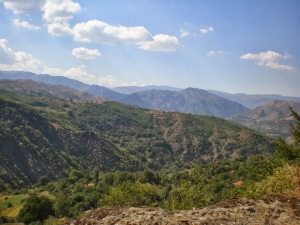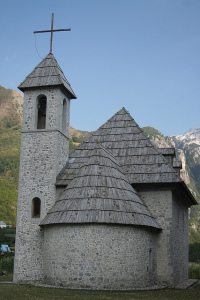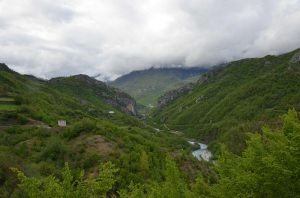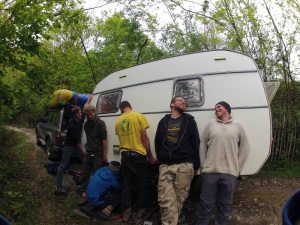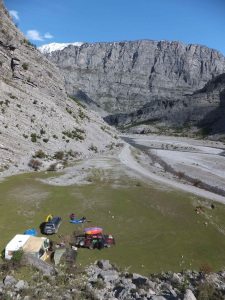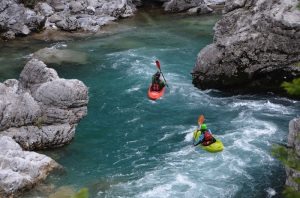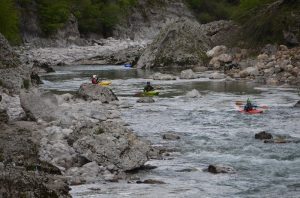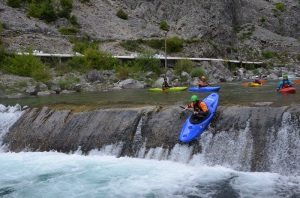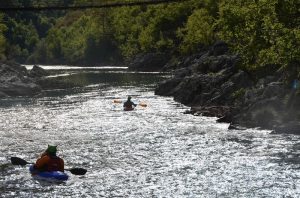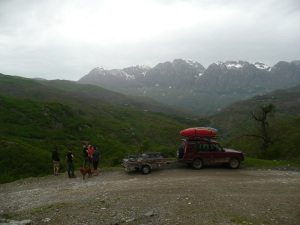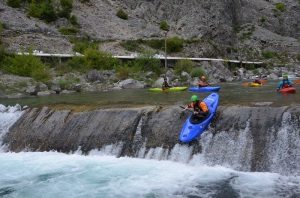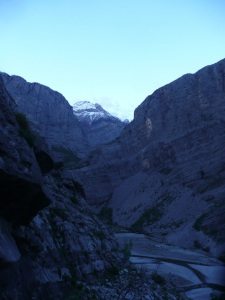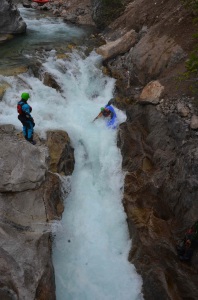The Blogger has been created to help you discover Albania, its culture, history, natural beauties, Archaeological sites, something that is difficult even to imagine. You might think you know Albania, because you may have heard about its fabulous places. Pictures do not provide you with the clear image of Albania, and therefore we offer you the opportunity to know Albania better, all the HISTORICAL arteries that spread throughout the country.
Search in This Blog
Translate
Sunday, March 29, 2015
Turizmi dhe Kultura, axhendë të përbashkët për restaurimin objekteve të trashëgimisë
Hoteleri Turizem Albania: Turizmi dhe Kultura, axhendë të përbashkët për res...: Postuar më 20:34 - 27 Mars 2015 nga Klajdi Musabelliu në Art, Kulture dhe Argetim , Lajme Nga Vendi TIRANË, 27 Mars / ATSH/-Përfaqës...
Thursday, March 26, 2015
Travel agencies to operate with a new contract model
- March 26th, 2015
- Tourism
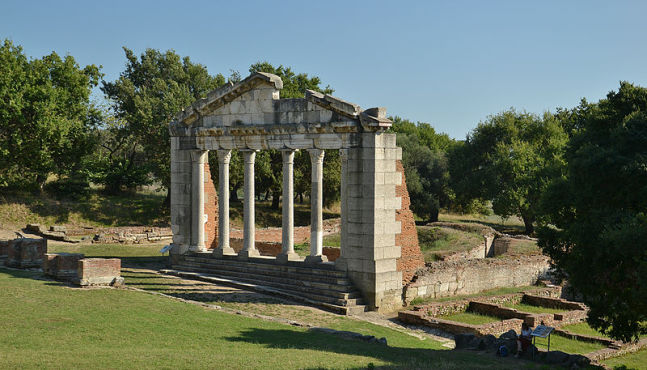 Albanian clients have often faced difficulties and problems when dealing with private travel agencies that operate in the country. In order to eliminate these problems, The Ministry of Economic Development and GIZ company have conducted a new contract model for the travel packages which are offered by Albanian travel agencies.
Albanian clients have often faced difficulties and problems when dealing with private travel agencies that operate in the country. In order to eliminate these problems, The Ministry of Economic Development and GIZ company have conducted a new contract model for the travel packages which are offered by Albanian travel agencies.
The new model was announced by the President of the Touristic Operators Union, Sadik Malaj, according to which, the model outlines the criteria, the conditions and the obligations addressed to the touristic operators in Albania. Malaj declared that the new touristic contracts may be collectives or individuals and in cases the travel agencies do not meet the conditions or the set criteria, they will be penalized.
There are no official statistic regarding the number or the activities of travel agencies which operate in Albania since these entities do not have to possess a license to operate but they register at the National Registration Center.
Albania and GIZ have cooperated in many projects, financed by the German government. GIZ service provider cooperates with the Albanian government on behalf of the German government and manages its funds and projects which are addressed to Albania.
News source/photo credits: ATA, Pudelek (Wikimedia)
Tuesday, March 24, 2015
Sunday, March 22, 2015
Top 10 ‘must visit’ cultural spots in Korça city for to visit in 2015
- March 17th, 2015
- Tourism
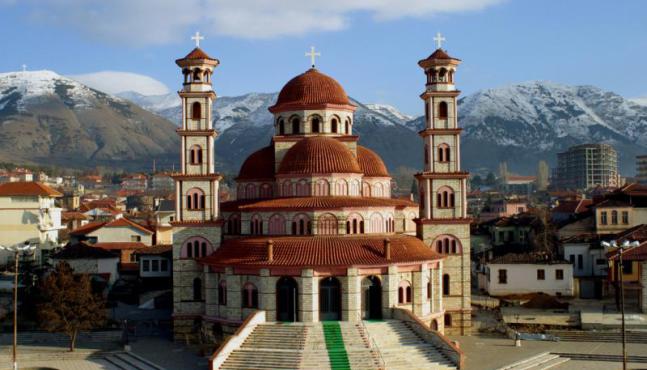 Korça is a wonderful city which carries a unique and diverse culture, old traditions and remarkable values of civilization. The high stage of development at the time of the Ottoman Empire rule and the renowned personalities for which the city if proud of, have made this city an inevitable touristic destination. Below we have listed top ten cultural attractions tourists must not miss if they find time to visit Korça.
Korça is a wonderful city which carries a unique and diverse culture, old traditions and remarkable values of civilization. The high stage of development at the time of the Ottoman Empire rule and the renowned personalities for which the city if proud of, have made this city an inevitable touristic destination. Below we have listed top ten cultural attractions tourists must not miss if they find time to visit Korça.
Photo credits: Gjergji P
The National Museum of Education
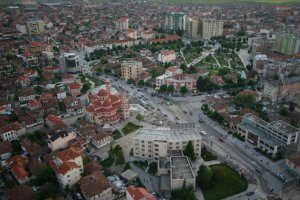 This museum represents the first Albanian school, opened on March 7th, 1887, mostly known as “Mësonjëtorja” for two main reasons. Firstly, it is established in the old and historical building of Mësonjëtorja and secondly, in its stents you can see the photocopy of the first Albania “Abetare”, the elementary book for learning Albanian alphabet and basis of the language.
This museum represents the first Albanian school, opened on March 7th, 1887, mostly known as “Mësonjëtorja” for two main reasons. Firstly, it is established in the old and historical building of Mësonjëtorja and secondly, in its stents you can see the photocopy of the first Albania “Abetare”, the elementary book for learning Albanian alphabet and basis of the language.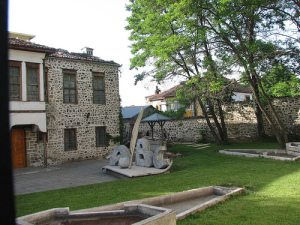 “Abetare” has been written by Naum Veqilharxhi and his photo portrait, along with other patriots and Albanian contributors are showcased in this museum. The Museum of Education showcases the original tracks of the first attempts of Albanian patriots in opening schools in Albanian language, in a continuous fight to win dependency from the Ottoman Empire.
“Abetare” has been written by Naum Veqilharxhi and his photo portrait, along with other patriots and Albanian contributors are showcased in this museum. The Museum of Education showcases the original tracks of the first attempts of Albanian patriots in opening schools in Albanian language, in a continuous fight to win dependency from the Ottoman Empire.
Photo credits: Xixa (Wikimedia)
The Mosque of Iliaz Bej Mirahor
This mosque is the most ancient one in Albania and at the same time is the most ancient monument of the city. It dates back to 1496, at the time when the city started to function as an administrative unit and holds the name of Iliaz Bej Mirahor (Ilia Panariti).
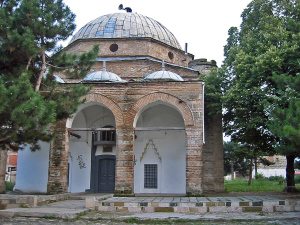 The mosque carries historical, cultural, religious and architectural values. It is the first dome mosque constructed with building blocks in Albania. In the interior it is painted in white color and its walls are decorated with paintings of Mecca and Medina sacred places.
The mosque carries historical, cultural, religious and architectural values. It is the first dome mosque constructed with building blocks in Albania. In the interior it is painted in white color and its walls are decorated with paintings of Mecca and Medina sacred places.
Photo credits: Albinfo (Wikimedia)
The Museum-House of the painter Vangjush Mio
The Museum- House of the impressionist painter Vangjush Mio was proclaimed a cultural monument and it contains approximately 40 paintings realized in oil, landscapes, quiet nature, and many other paintings which are known for their highly uncommon style.
Vangjush Mio is distinguished as an Albanian landscape painter and he is the first Albanian painter that opened the first exhibition in Tirana in 1920, whereas in 1942 he opened his own exhibition in Bari.
Photo credits: Pixnet
“Republika” Boulevard
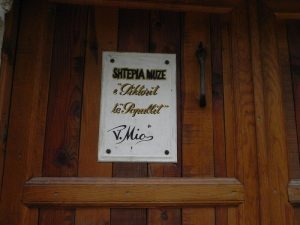 This boulevard is considered a culture monument for its characteristic houses with railings, the trees and flowers which flourish during the spring and summer seasons and make the boulevard a unique place to take a walk. The citizens of Korça have since called it the “boulevard of promenades” because is the perfect place for walking at evenings. The boulevard is the place where you can have a coffee at the best bars in town.
This boulevard is considered a culture monument for its characteristic houses with railings, the trees and flowers which flourish during the spring and summer seasons and make the boulevard a unique place to take a walk. The citizens of Korça have since called it the “boulevard of promenades” because is the perfect place for walking at evenings. The boulevard is the place where you can have a coffee at the best bars in town.
Photo credits: Gjergji P (Panoramio)
It is known as the place where the emigrants of the XIX century were seen off. Korça is the only city that has such a place which is protected, dedicated to the root of emigration, often known as the point “where there the city ended” since among tears and candles wives waited for their long-gone husbands or for good news from them. During the XIX century this lawn turned into emigrants’ temple. In the period when Korça enumerated not more than 12 thousand inhabitants, the “The Valley of Tears” was a crossroad between Albania and the other side of the border.
Photo credits: korcajone (Panoramio)
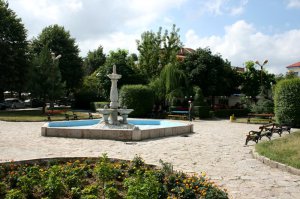 A century ago this valley was situated on the way to Manastir and Thessaloniki, from where Albanians started their migration to Turkey, Romania, Bulgaria and America. The remittances brought by emigrants helped families’ economies and as a consequence affected in city’s culture by bringing new foreign cultural elements which Korca city has inherited from the past.
A century ago this valley was situated on the way to Manastir and Thessaloniki, from where Albanians started their migration to Turkey, Romania, Bulgaria and America. The remittances brought by emigrants helped families’ economies and as a consequence affected in city’s culture by bringing new foreign cultural elements which Korca city has inherited from the past.
“The Valley of Tears” which carries the same name even nowadays, once was a valley where people used to cry for their loved ones and today represents a recreational area for the citizens.
The Bazaar
The old bazaar of the city constitutes a valued object according to the historical, cultural and artistic viewpoint. It is characterized by one and two floor buildings, narrow paths and a unique construction style which attracts the visitors’ attention.
In the past centuries the bazaar was the place of trade and a crossroad of merchants coming from the east or the west of the continent.
It was known for the inns located one after the other and it is of importance to distinguish the Inn of Elbasan and the Inn of Manastir which at their flourishing served as dormitories during the end of the XIX century and the beginning of the XX century. In the city planning structure the bazaar constituted a separated gathering.
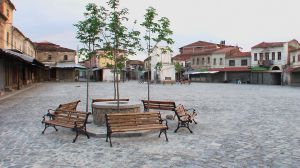 Both sides of the Bazaar which were separated by the river were connected to each other by wooden bridges, while the main road coming from the city passed the river on a stone vault bridge, above which stood shops. The bazaar was buried three times but it was constructed again and again. Now the bazaar continues functioning as before and it carries historical and monumental values.
Both sides of the Bazaar which were separated by the river were connected to each other by wooden bridges, while the main road coming from the city passed the river on a stone vault bridge, above which stood shops. The bazaar was buried three times but it was constructed again and again. Now the bazaar continues functioning as before and it carries historical and monumental values.
Photo credits: Joergsam (Wikimedia)
“Resurrection of Christ” Orthodox Cathedral
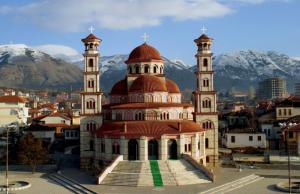 The cathedral is built in 1994 and it belongs to the orthodox denomination. Based on its dimensions it is denoted as the most important in Korça and the greatest in Albania. “Christ Revival” Cathedral has three floors and it occupies an area of 1500 square meters.
The cathedral is built in 1994 and it belongs to the orthodox denomination. Based on its dimensions it is denoted as the most important in Korça and the greatest in Albania. “Christ Revival” Cathedral has three floors and it occupies an area of 1500 square meters.
Photo credits: Go Albania
Photo credits: Gjergji P (Panoramio)
“Youth” Park
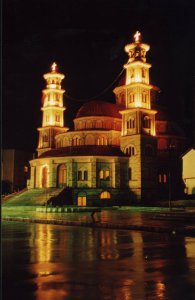 This Park is the area of promenades and the “first kisses” for all those living in Korça. Nowadays the park is an open gallery of the contemporary art of stone sculptures. Korça is the first city in Albania that has welcomed every year sculptors from all over the world who realize and showcase their compositions, adding this way a prominent value to the city, a value which is related to the early tradition of stonework in this city. In this park one could enjoy the open gallery of the modern art sculptures in stone and take a walk surrounded by culture, sculpture and great artists’ works.
This Park is the area of promenades and the “first kisses” for all those living in Korça. Nowadays the park is an open gallery of the contemporary art of stone sculptures. Korça is the first city in Albania that has welcomed every year sculptors from all over the world who realize and showcase their compositions, adding this way a prominent value to the city, a value which is related to the early tradition of stonework in this city. In this park one could enjoy the open gallery of the modern art sculptures in stone and take a walk surrounded by culture, sculpture and great artists’ works.
Photo credits: Visit Korca
The Oriental Art Museum “Bratko” was opened in July 2003, accomplishing this way the dream of Dhimiter Borja (1903-1990), artist, photograph and also a collector of Asian art and antiques. Borja was born in Korça, despite of the fact that he travelled a lot around the world and then was situated in America throughout the great part of his life.
Photo credits: Snipview
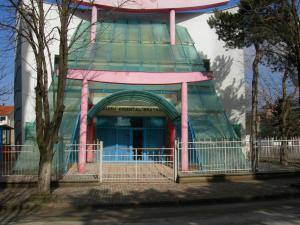 In this museum there are exposed 432 objects such as piano, Chinese Altars, Japanese WOMEN CLOTHING
In this museum there are exposed 432 objects such as piano, Chinese Altars, Japanese WOMEN CLOTHING , Chinese skirts and belts, Indonesian swords, European medals, Japanese paintings, different photographs, which Borja has realized while serving in Balkan under UNO’s Mission. The photo images are really uncommon. They show the social and cultural history immediately after the war as well as the important role played by the general MacArthur in the economical and institutional reconstruction of Japan. The archivist Zobel states about Boria: “He was a genius. He came to this place with the hands on the pocket and succeeded in becoming famous. This is enough to show his strong character.”
, Chinese skirts and belts, Indonesian swords, European medals, Japanese paintings, different photographs, which Borja has realized while serving in Balkan under UNO’s Mission. The photo images are really uncommon. They show the social and cultural history immediately after the war as well as the important role played by the general MacArthur in the economical and institutional reconstruction of Japan. The archivist Zobel states about Boria: “He was a genius. He came to this place with the hands on the pocket and succeeded in becoming famous. This is enough to show his strong character.”
The old neighborhoods of Korca
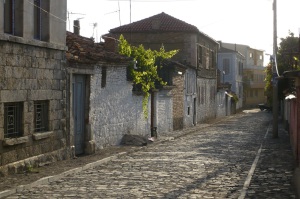 The old neighborhoods of Korça are situated on the eastern part of the city, behind the church “Christ Revival”, at the entrance of “Republic” boulevard and that of “Shen Gjergji”. Generally the old houses are well – kept and they deserve a visit. In the first decades of the XX century the enrichment of the bourgeoisie displayed the contrast between the old area of the city, which settled in Penço and Manço neighborhoods (the areas over the monument of the National Combatant) became really obvious. Whereas in the old area of the city there was noticed the typical city planning of medieval Balkan centers with their narrow twisting paths and with low buildings, not organized; in the new area neighborhoods the paths were straight and they formed building parcels.
The old neighborhoods of Korça are situated on the eastern part of the city, behind the church “Christ Revival”, at the entrance of “Republic” boulevard and that of “Shen Gjergji”. Generally the old houses are well – kept and they deserve a visit. In the first decades of the XX century the enrichment of the bourgeoisie displayed the contrast between the old area of the city, which settled in Penço and Manço neighborhoods (the areas over the monument of the National Combatant) became really obvious. Whereas in the old area of the city there was noticed the typical city planning of medieval Balkan centers with their narrow twisting paths and with low buildings, not organized; in the new area neighborhoods the paths were straight and they formed building parcels.Two villages to explore in Albania, perfect destinations for backpackers in 2015
- March 18th, 2015
- Tourism
 Tourism in Albania has been mostly focused in beaches and known natural resorts or National Parks but this small country is a real oasis of natural stunning places as there are many yet unknown destinations to visit in country. Considered as an unexplored country, Albania has yet unexplored touristic spots, remote villages with untouched nature by the hand of humans. For all curious and adventurous tourists, Stebleva and Gllave villages are the perfect destination to visit and explore during the entire year.
Tourism in Albania has been mostly focused in beaches and known natural resorts or National Parks but this small country is a real oasis of natural stunning places as there are many yet unknown destinations to visit in country. Considered as an unexplored country, Albania has yet unexplored touristic spots, remote villages with untouched nature by the hand of humans. For all curious and adventurous tourists, Stebleva and Gllave villages are the perfect destination to visit and explore during the entire year.
Stebleva
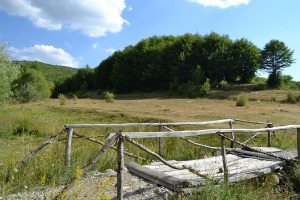 Stebleva is an untouched natural oasis of the mountainous tourism situated in the eastern part of the Middle Albania and bordered by Macedonia, often described as a natural theatre for the wonderful interweaving of mountains, lawns, forests and rivers.
Stebleva is an untouched natural oasis of the mountainous tourism situated in the eastern part of the Middle Albania and bordered by Macedonia, often described as a natural theatre for the wonderful interweaving of mountains, lawns, forests and rivers.
The highest peak of this village is “Maja e Zeze” (Black Peak) at an altitude of 2225 meters, and the second highest peak is Raduci mountain at an altitude of 2084 meters above the sea level, situated in the east of Stebleva. The village is permeated by small rivers and streams which form the “Zalli i Stebleves” river known for a rare species of fish known as the river trout (know as mountain trout or in Latin as Salmo truta fario), which in Gjorica village in Dibra county joins the Black Drin river.
The Albanian government announced the massif of “Studën – Kallkan – Jabllanicë – Kodra e Borovës – Dragan” as a state protected area, which highlights the importance of the area as a potential and promising touristic destination in the country, yet unexplored.
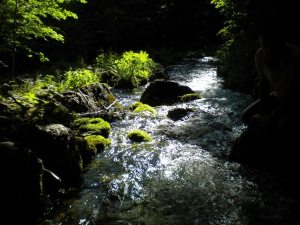 Despite the natural spots the visitors may explore in Stebleva village, another exploring alternative is the visit in the karstic lake which is surrounded by ancient rocks and is located in the Dragani Mountain. Stebleva offers extraordinary opportunities for skiing in the natural pistes of mountain sites and other mountain sports during all seasons of the year in Kallkani and Mllaci mountains.
Despite the natural spots the visitors may explore in Stebleva village, another exploring alternative is the visit in the karstic lake which is surrounded by ancient rocks and is located in the Dragani Mountain. Stebleva offers extraordinary opportunities for skiing in the natural pistes of mountain sites and other mountain sports during all seasons of the year in Kallkani and Mllaci mountains.
During the nineties, Stebleva was known for the developed livestock activity by the locals and the timbers that were used as raw material by joinery factories. The construction of Tirane – Elbasan road has reduced the length of the distance of Stebleva village with Tirana capital by 75 kilometers. A very important investment by the government will be the establishment of a bordering cross point of Albania with Macedonia. This will attract Macedonian tourists to visit the village since Stebleva is situated only 30 minutes from Macedonian city of Struga.
Photo credits: Stebleva Travel
Gllava
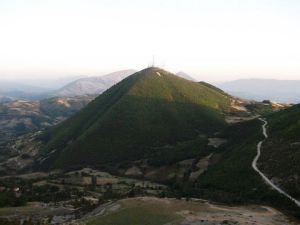 Gllava village is situated in the remote areas of southern Albania, part of Tepelena district and situated in the crossroad of Tepelene, Skrapar and Permet cities. It is a mountainous village with an uncommon natural beauty. The locals live by selling agricultural and farming products and by utilizing the touristic resources to increase their revenues.
Gllava village is situated in the remote areas of southern Albania, part of Tepelena district and situated in the crossroad of Tepelene, Skrapar and Permet cities. It is a mountainous village with an uncommon natural beauty. The locals live by selling agricultural and farming products and by utilizing the touristic resources to increase their revenues.
Being aware of the potential this village has in terms of mountainous tourism, the locals have started transforming the environment by adapting their houses for tourists and transforming them into typical Albanian guesthouses. They also have started adapting and utilizing many water resources of the area for tourism purposes.
Gllava is a very attractive and exciting destination for backpackers and curious tourists who seek to explore the country.
Saturday, March 21, 2015
To conquer peaks in all seasons, this is the aim of climbers that add challenges and always face the emotions that rarely who can prove.
To conquer peaks in all seasons, this is the aim of climbers that add challenges and always face the emotions that rarely who can prove.
Certainly the most difficult peaks are professionals and 65 climbers Albanian federation chose Nëmërçkë pinnacle of Papingut in the Municipality to show that succeed anywhere.
Ascent to the top high-started at 300 meters to continue to height 1600 meters above sea level under the guidance of masters and Noble Arthur Guni Muça.
Nature has blessed Përmeti rare beauty with wonderful fracture of relief that make climbing alpinism an adventure in itself.
If you think you are in a program of discovery, not to be confused as to exactly are our climbers after a climb like wild nature program.
Setting up tents and spending the night in snow white robe makes the challenge more interesting. Temperature during the night of passing -8 degrees, but with the proper equipment and clothing climbers succeeded.
And while they are near the tip Arthur expressed quite happy for adhesion and good weather is very important for this challenge.
Managed to climb to the top, especially women, who are already part of mountaineers climbing difficult.
While preparing for another challenge, another trip and other impressive achievements, climbers managed to show us the natural beauty of our country, but rarely appreciate.
.....Të pushtojnë majat në të gjitha stinët, ky është edhe qëllimi i alpinistëve që shtojnë sfidat dhe përballen gjithmonë me emocione që rrallë kush mund ti provojë.
Sigurisht që majat më të vështira janë për profesionistët dhe 65 alpinistë të federatës shqiptare zgjodhën Majën e Papingut në Nëmërçkë të Përmetit për të treguar se ia dalin kudo.
Ngjitja drejt majës së lartë nisi në nivelin 300 metra për të vazhduar deri në lartësinë 1600 metra mbi nivelin e detit nën drejtimin e mjeshtrave Artur Guni e Fisnik Muça.
Natyra i ka falur Përmetit bukuri të rralla me thyerje të mrekullueshme të relievit që e bëjnë ngjitjen alpinistike një aventurë më vete.
Nëse mendoni se jemi në një program të discovery, mos u ngatërroni pasi janë pikërisht alpinistët tanë që pasi ngjiten si në një program të natyrës së egër.
Vendosja e cadrave dhe kalimi i natës në këtë petk të bardhë dëbore e bën sfidën më interesante. Temperatura gjatë natës i kalonte -8 gradë, por me pajisjet dhe veshjet e duhura alpinistët ia dolën.
E ndërsa janë afër majës Arturi shprehet mjaft i kënaqur për ngjitjen dhe motin e mirë që është shumë i rëndësishmë për këtë sfidë.
Ia dolën të ngjiteshin në majë sidomos femrat, që tashmë janë pjesë e ngjitjeve të vështira të alpinistëve.
E ndërsa përgatiten për një tjetër sfidë, një tjetër udhëtim mbreslënës dhe të tjera arritje, alpinistët arritën të na tregojnë edhe bukuritë natyrore që ka vendi ynë, por që rrallë herë i vlerësojmë.
Redaksia online
(f.m/shqiptarja.com) - See more at: http://shqiptarja.com/aktualitet/2731/alpinist-t-n--maj-n-e-n-m-ck-s--kalohet-edhe-sfida-e-radh-s--280368.html#sthash.GMTRwCMV.dpuf
Sunday, March 15, 2015
Thursday, March 12, 2015
Monday, March 9, 2015
Albania’s touristic potential presented at Euronews ( ITB Berlin 2015 )
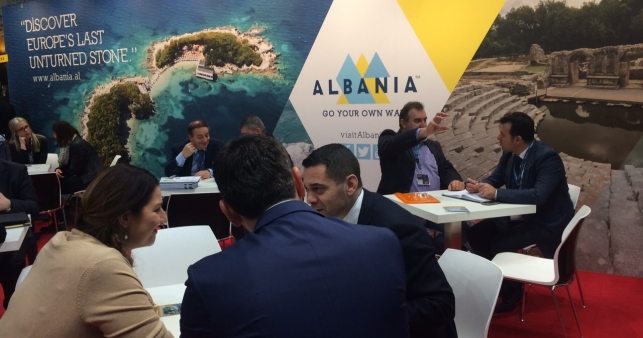
- March 9th, 2015
- Tourism
Promoting a country in the international market is very expensive and requires a lot of work, but smart promoting is the key. During the last years, Albania has increased its appearance in regional and international fairs and promoting events, in order to show to the world its touristic, yet undiscovered potential. Knowing the importance of this, the Albanian government has worked in promoting the country also in international media, which have presented Albania as Europe’s last corner, or as the hidden bargain of the Balkans, Europe’s last unturned stone, ect.
The latest international fair Albania attended was that of ITB international fair which took place in Berlin, Germany. Besides the staff of National Agency of Coastline, present in this fair was also the Minister of Economic Development, Trade, Entrepreneurship and Tourism Arben Ahmetaj.
During an interview with the international news agency Euronews, Ahmetaj highlighted the touristic values of Albania, adding that the country is continually becoming more and more attractive to European tourists.
“It is about a totally different tourism,” declared the Minister. “Tourism in Albania is clean, simple and enjoyable, at low costs and very hospitable. Tourists can visit and enjoy pristine beaches, clean sand and coastline, delicious Mediterranean food and a lot of entertaining places. We offer tourism for those who do not want to spend much, for those who want an exclusive tourism and for those who want to spend more,” declared Ahmetaj for Euronews.
News source: EuronewsPhoto credits: Ministry of Tourism
Theth National Park and the phenomenon of “kulla”
- January 29th, 2015
- Tourism
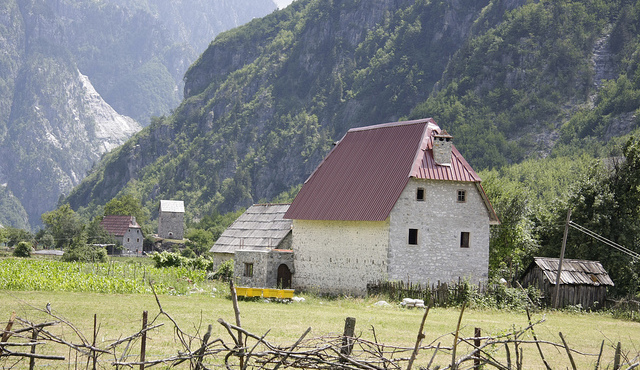 Theth National Park is one of the most visited touristic spots in Albania. With a very old tradition, Theth village has a lot to offer to foreign tourists that are curious about lifestyle and old traditions which still get practiced by locals. Despite natural beauties, a very interesting element of Theth village is Kulla, a typical house of this village.
Theth National Park is one of the most visited touristic spots in Albania. With a very old tradition, Theth village has a lot to offer to foreign tourists that are curious about lifestyle and old traditions which still get practiced by locals. Despite natural beauties, a very interesting element of Theth village is Kulla, a typical house of this village.
Kulla served once upon a time as a shelter for families involved in blood feud. Men of the family used to confine themselves inside Kulla, otherwise they would get killed by people they had conflicts with.
The region has a lot of old traditions, values and lifestyle elements which impress foreign tourists and writers as well. The winner of Nobel Prize in Literature for 2013 Alice Munro has written a book called “The Albanian virgin” that tells the story of a foreign girl who due to an accident while exploring Balkan, ends up kidnapped by some member of Geg tribe. As the story comes to its peak, the writer describes many traditions and customs of Geg tribe, which have lived in northern Albania.
But Kulla is not the only element that recalls the old culture and traditions of this region. If you visit it, you will see that old women still wear their old traditional costumes, still cook old and traditional dishe and still behave in a slavish manner towards their husbands and male family members.
Photo credits: Andrea Dell’Amico, coloeus (Flickr)
KayakSession: Albanian Whitewaters, Europe’s Underrated Paddling Destination in 2015
- February 6th, 2015
- Op/Ed
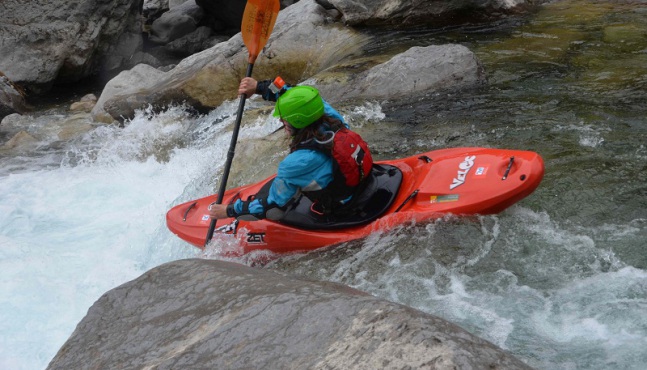
This is not an original article of invest-in-albania.org website. The article was first published at KayakSession by Sandra Sebelin.
In early summer of 2014, a team of four Germans, four Austrians and a dog loaded into a campervan and a jeep headed for the Albanian Alps. Many people picture Albania as totally destroyed by conflict or even still at war, so reactions to the trip from friends, family and colleagues ranged from surprise to serious skepticism. What most people don’t know is that Albania is an eastern European El Dorado for whitewater kayakers.
We started to prepare six months before the trip: researching Northern Albania, sorting out vehicles, collecting donations of clothes and shoes for people we met along the way, and, once early spring hit, paddling as much as we could in the German Alps.
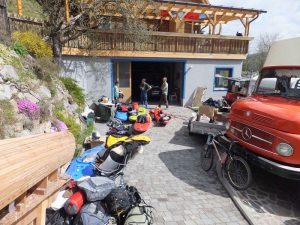 At last it was time to depart. We began our journey in Austria, crossing Slovenia, Croatia, Bosnia and Herzegovina, and Montenegro. To break up the trip we stopped first at the Cetina in Croatia. We then enjoyed beautiful cataracts and clear water at the Moraca in Montenegro, which made us look forward to our first destination in Albania – the Cemit Valley – which carves its way through fascinating rock, green valleys and broad plains. Tight lines twisting through boulder garden drop characterized the upper part of the Cemit, but most memorable were the numerous invitations extended by the locals for coffee and rhaki (a homemade alcohol made from feremented fruit) in their homes. The middle section of the run opened up to green hillsides before closing back into a spectacular small canyon toward the end of the run.
At last it was time to depart. We began our journey in Austria, crossing Slovenia, Croatia, Bosnia and Herzegovina, and Montenegro. To break up the trip we stopped first at the Cetina in Croatia. We then enjoyed beautiful cataracts and clear water at the Moraca in Montenegro, which made us look forward to our first destination in Albania – the Cemit Valley – which carves its way through fascinating rock, green valleys and broad plains. Tight lines twisting through boulder garden drop characterized the upper part of the Cemit, but most memorable were the numerous invitations extended by the locals for coffee and rhaki (a homemade alcohol made from feremented fruit) in their homes. The middle section of the run opened up to green hillsides before closing back into a spectacular small canyon toward the end of the run.
Cemit Valley
Right after crossing the border into Albania, where the officials did not know what to make of our kayaks, the paved highway ended and a dirt road led into the Cemit Valley. The Cemit River carves its way through fascinating rock, green valleys and broad plains. We found a perfect camping place behind the village of Tamare, next to the river. Sun and snow white hills greeted us the next morning. We bought food from a fisherman and he told us the weather forecast. Communication with the local residents was not a problem because the young people speak English perfectly. A small supermarket in Tamare sold food, clothes, tools and almost everything you might need. On the streets we witnessed free-roaming pigs, cows and donkeys. The rivers are no comparison to the Alps but are clear and clean. The Cemit goes along the Montenegrin border and challenges its paddlers in various ways. Tight lines twisting through boulder garden drop characterized the upper part of the Cemit, and the middle section of the run opened up to green hillsides before closing back into a spectacular small canyon toward the end of the run. Perhaps most memorable were the numerous invitations extended by the locals for coffee and raki (a homemade alcohol made from fermented fruit) in their homes. The hospitality, respect and openness were overwhelming, especially in the upper part of the valley.
Kir Valley
Our next stop was Kir Area and the district capital, Shkodra, where we refilled our stocks of food. After the chaos of cars and people in Shkodra, we happily made our way back to nature. On our way to the next paddling area we passed mosques and small farmhouses. The sections of the Kir alternated between exciting rapids and flatwater. At the end of the Kir Valley, the river ran into a small gorge with super challenging whitewater. Jumbled piles of conglomerate rock blocking the river and numerous siphons meant swimming was not an option on this section. Because water levels were already low and there was no prospect of increased flow, we left straight to Shala. With Mountainbikes and full safety equipment we used the street as trails due to the fact that the van surrendered under the poor street conditions.
Shala
At the top of a pass on the way to Shala, we decided to take a break at a café. These roadside cafés served as restaurant, bar and bus stop all at the same time. Afterward, we were onward to our final destination: The Shala valley, situated next to the national park of Theth, with the highest mountains of Northern Albania. We were overwhelmed by the view of this valley, which filled us with excitement. Bright limestone, green mountains and the crystal clear, blue water of the Shala made our kayaker hearts beat fast with anticipation.
 To recon the area we needed a few days. Along with paddling, there are great possibilities for hiking, climbing and mountain biking there. The upper part the river is blocked by significant rockfall and it took us many hours of scouting and paddling to make our way through those sections. The technical whitewater consists of small drops and must-runs. At the village of Nicaj the valley opened and the sections got easier, with the exception of one maze of rocks and siphons that was impassable at the low water levels we had. The recreation potential in the valley convinced us to extend our stay by a few days, and the time on the water and in Mother Nature was invaluable.
To recon the area we needed a few days. Along with paddling, there are great possibilities for hiking, climbing and mountain biking there. The upper part the river is blocked by significant rockfall and it took us many hours of scouting and paddling to make our way through those sections. The technical whitewater consists of small drops and must-runs. At the village of Nicaj the valley opened and the sections got easier, with the exception of one maze of rocks and siphons that was impassable at the low water levels we had. The recreation potential in the valley convinced us to extend our stay by a few days, and the time on the water and in Mother Nature was invaluable.
Travel days in Albania were always a battle between our vehicles and the terrible road conditions, and on our way out of the Shala Valley the roads finally claimed victory. No temporary patch seemed to work on the van, so we were forced to leave it in the valley. Some shepherd will now enjoy a new shelter from the weather!
In the end, however, any infrastructure challenges were a worthy sacrifice for such a rewarding journey in an incredible place. Exciting whitewater, friendly and hospitable people, and unique rivers and wild places will definitely have us returning to Albania in the very near future.
Words: Sandra Sebelin Photography: Jörg Zisser, Florian Geldermann, Zwischak Geldermann, Sandra Sebelin, Benjamin Kirn
Subscribe to:
Posts (Atom)

